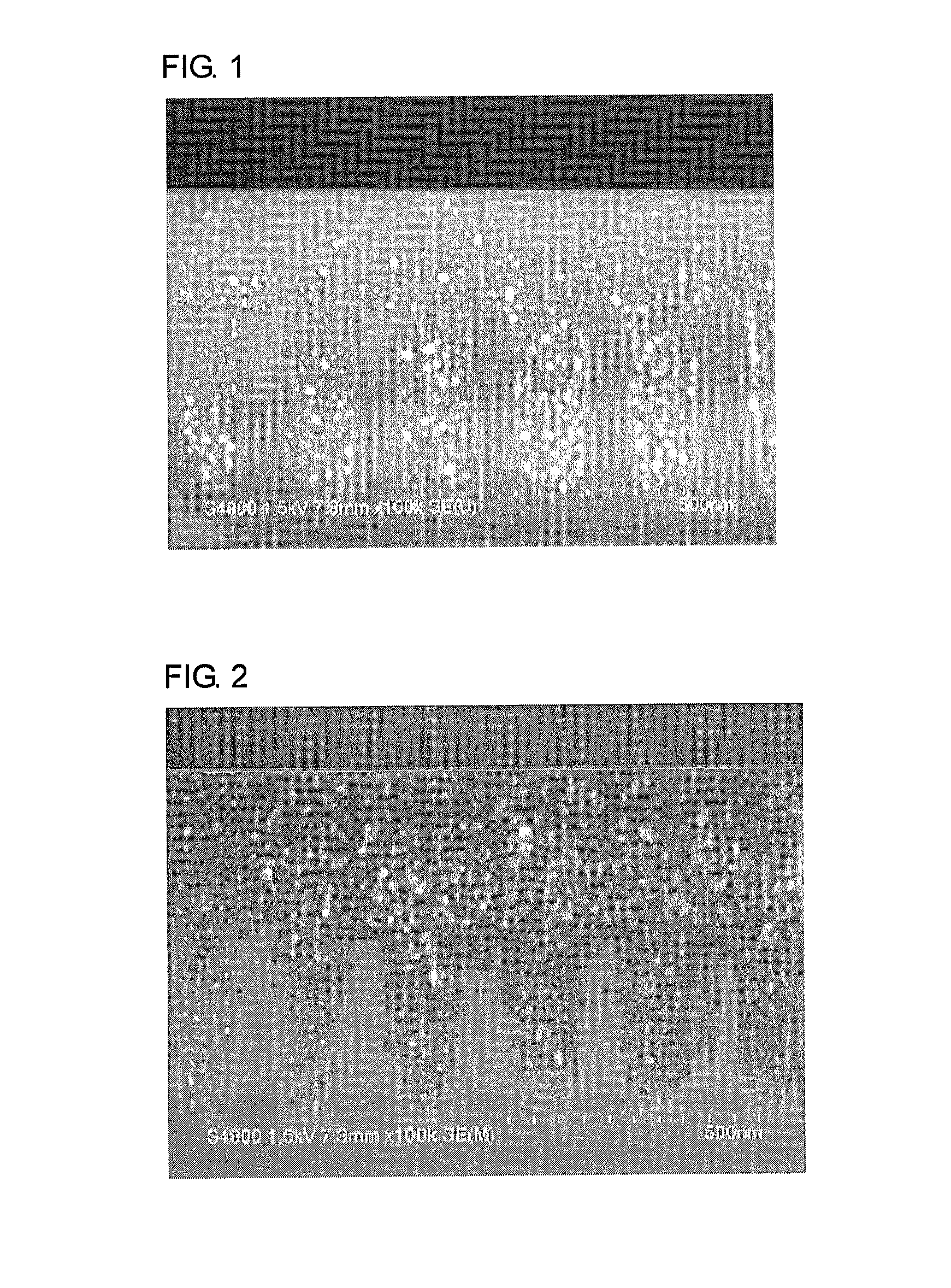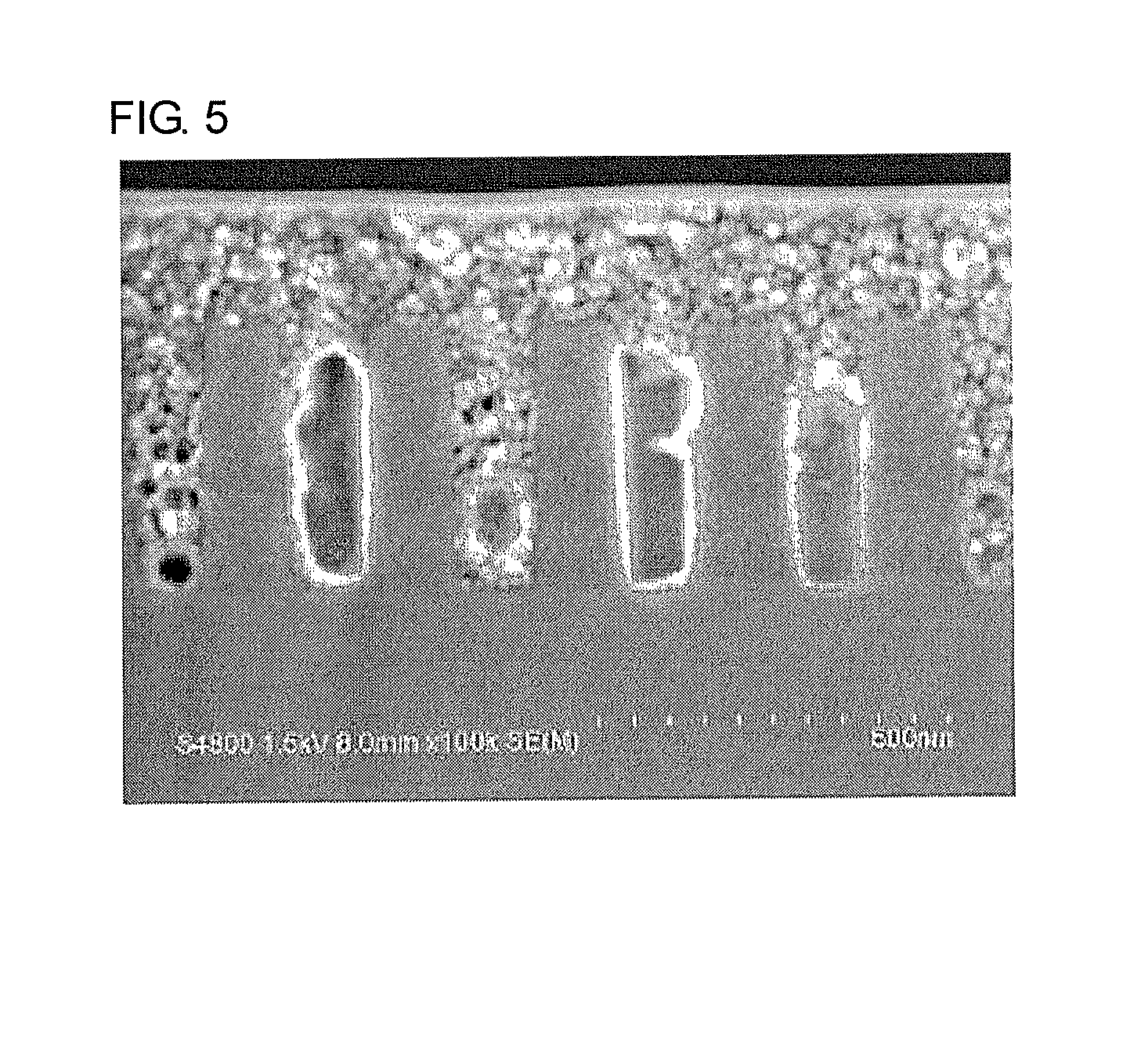Resist underlayer film forming composition containing phenylindole-containing novolac resin
- Summary
- Abstract
- Description
- Claims
- Application Information
AI Technical Summary
Benefits of technology
Problems solved by technology
Method used
Image
Examples
synthesis example 1
[0106]To a 100 mL four-necked flask, 2-phenylindole (4.00 g, 0.021 mol, manufactured by Tokyo Chemical Industry Co., Ltd.), 1-naphthaldehyde (3.23 g, 0.021 mol, manufactured by Tokyo Chemical Industry Co., Ltd.), and p-toluene sulfonic acid monohydrate (0.619 g, 0.0031 mol, manufactured by KANTO CHEMICAL CO., INC.) were added and then toluene (14.58 g, manufactured by KANTO CHEMICAL CO., INC.) was charged. The mixture was stirred and a temperature of the mixture rose to 110° C. to dissolve the mixture and to start polymerization. After 50 minutes, the resulting mixture was allowed to cool to room temperature and was reprecipitated in methanol (300 g, manufactured by KANTO CHEMICAL CO., INC.). The obtained precipitate was filtered and dried at 50° C. for 10 hours in a vacuum drier to obtain 4.5 g of a target polymer (Formula (2-2), hereinafter abbreviated as PId-NA).
[0107]A weight average molecular weight Mw and a polydispersity Mw / Mn of PId-NA measured by GPC in terms of polystyrene...
synthesis example 2
[0108]To a 100 mL four-necked flask, 2-phenylindole (3.50 g, 0.018 mol, manufactured by Tokyo Chemical Industry Co., Ltd.), 1-pyrene-carboxaldehyde (4.17 g, 0.018 mol, manufactured by Tokyo Chemical Industry Co., Ltd.), and p-toluene sulfonic acid monohydrate (0.541 g, 0.0027 mol, manufactured by KANTO CHEMICAL CO., INC.) were added and then 1,4-dixoane (15.25 g, manufactured by KANTO CHEMICAL CO., INC.) was charged. The mixture was stirred and a temperature of the mixture rose to 110° C. to dissolve the mixture and to start polymerization. After 24 hours, the resulting mixture was allowed to cool to room temperature and was reprecipitated in methanol (250 g, manufactured by KANTO CHEMICAL CO., INC.). The obtained precipitate was filtered and dried at 50° C. for 10 hours and further 120° C. for 24 hours in a vacuum drier to obtain 3.7 g of a target polymer (Formula (2-7), hereinafter abbreviated as PId-Py).
[0109]A weight average molecular weight Mw and a polydispersity Mw / Mn of PId-...
example 1
[0112]With 20 g of the resin obtained in Synthesis Example 1, 0.06 g of Megafac R-30 (trade name, manufactured by Dainippon Ink and Chemicals Co., Ltd.) as the surfactant was mixed and the mixture was dissolved in 80 g of propylene glycol monomethyl ether acetate to form a solution. Thereafter, the solution was filtered with a polyethylene microfilter having a pore diameter of 0.10 μm and further filtered with a polyethylene microfilter having a pore diameter of 0.05 μm to prepare a solution of a resist underlayer film forming composition used for a lithography process of a multilayer film.
PUM
| Property | Measurement | Unit |
|---|---|---|
| Structure | aaaaa | aaaaa |
| Thermal resistance | aaaaa | aaaaa |
Abstract
Description
Claims
Application Information
 Login to View More
Login to View More - R&D
- Intellectual Property
- Life Sciences
- Materials
- Tech Scout
- Unparalleled Data Quality
- Higher Quality Content
- 60% Fewer Hallucinations
Browse by: Latest US Patents, China's latest patents, Technical Efficacy Thesaurus, Application Domain, Technology Topic, Popular Technical Reports.
© 2025 PatSnap. All rights reserved.Legal|Privacy policy|Modern Slavery Act Transparency Statement|Sitemap|About US| Contact US: help@patsnap.com



